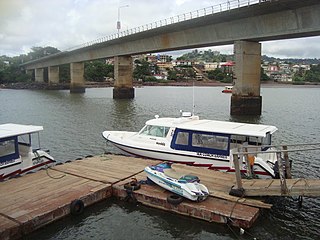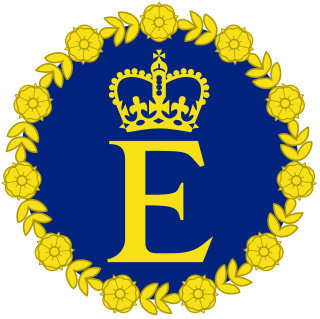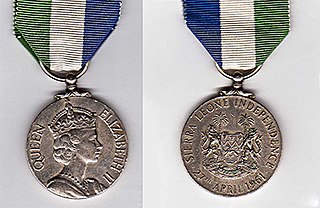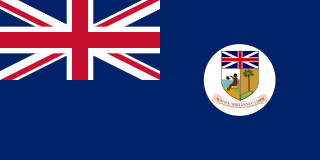| |||||
| Decades: | |||||
|---|---|---|---|---|---|
| See also: | |||||
The following lists events that happened during 1961 in Sierra Leone .
| |||||
| Decades: | |||||
|---|---|---|---|---|---|
| See also: | |||||
The following lists events that happened during 1961 in Sierra Leone .

There are a number of systems of transport in Sierra Leone, a country in West Africa, which possess road, rail, air and water infrastructure, including a network of highways and several airports.

Freetown is the capital and largest city of Sierra Leone. It is a major port city on the Atlantic Ocean and is located in the Western Area of the country. Freetown is Sierra Leone's major urban, economic, financial, cultural, educational and political centre, as it is the seat of the Government of Sierra Leone. The population of Freetown was 1,055,964 at the 2015 census.

Elizabeth II was Queen of Malta as head of state of Malta from 1964 to 1974. Malta was an independent sovereign state and a constitutional monarchy, sharing a monarch with other Commonwealth realms, including the United Kingdom. Elizabeth's constitutional roles in Malta were mostly delegated to a governor-general.

The Operational Service Medal for Sierra Leone is a campaign medal established in 2000 by the Ministry of Defence of the United Kingdom for participation in the British military intervention during and after the Sierra Leone Civil War, from May 2000 to July 2002.

The Sierra Leone River is a river estuary on the Atlantic Ocean in Western Sierra Leone. It is formed by the Bankasoka River and Rokel River and is between 4 and 10 miles wide (6–16 km) and 25 miles (40 km) long. It holds the major ports of Queen Elizabeth II Quay and Pepel. The estuary is also important for shipping. It is the largest natural harbour in the African continent. Several islands, including Tasso Island, Tombo Island, and the historically important Bunce Island, are located in the estuary.

Queen Elizabeth II had a variety of flags to represent her personally and as head of state of several independent nations around the world. They were usually used on any building, ship, car, or aircraft where she was present.

Queen Elizabeth II Quay, also known as QE II Quay and by residents as the Deep Water Quay, is a locality in Freetown, Sierra Leone. It is located on a promontory called Fourah Point on the southern bank of the estuary of the Sierra Leone River between Destruction Bay and Cline Bay within the suburb of Cline Town directly to the east of central Freetown. It is the larger of two harbors within Freetown, the other harbor known as Government Wharf, Freetown Port, or simply "the harbor" and is Freetown's more centrally located harbor.

This is a survey of the postage stamps and postal history of Sierra Leone.

The Sierra Leone Independence Medal was authorised by Queen Elizabeth II on the occasion of the granting of independence to Sierra Leone, to give recognition to individuals of the Royal Sierra Leone Military Forces, Sierra Leone Naval Volunteer Force and the Police Force who were serving on the 27 April 1961. Members of United Kingdom Land Forces seconded to the Royal Sierra Leone Military Forces also qualified.

The Dominion of Sierra Leone was a sovereign state with Queen Elizabeth II as its head of state between independence on 27 April 1961 and becoming the Republic of Sierra Leone on 19 April 1971.

Elizabeth II was Queen of Mauritius as well as its head of state from 1968 to 1992 when Mauritius was an independent sovereign state and a constitutional monarchy within the Commonwealth of Nations. She was also the monarch of other Commonwealth realms, including the United Kingdom. Her constitutional roles in Mauritius were delegated to a governor-general. Mauritius became a republic in 1992.

Elizabeth II was Queen of Sierra Leone from 1961 to 1971, when Sierra Leone was an independent constitutional monarchy. She was also the monarch of other Commonwealth realms, including the United Kingdom. Her constitutional roles in Sierra Leone were mostly delegated to the governor-general of Sierra Leone.

The Constitution of Sierra Leone is the supreme law governing Sierra Leone and delineates its frame of government. It entered into force on October 1, 1991, following a popular referendum and approval by President Joseph Momoh. It superseded the 1978 Constitution.

The Colony and Protectorate of Sierra Leone was the British colonial administration in Sierra Leone from 1808 to 1961, part of the British Empire from the abolitionism era until the decolonisation era. The Crown colony, which included the area surrounding Freetown, was established in 1808. The protectorate was established in 1896 and included the interior of what is today known as Sierra Leone.

A number of new Sierra Leonean medals were instituted in the decade from 1961, when the country gained independence, until 1971, when Sierra Leone was declared a republic.